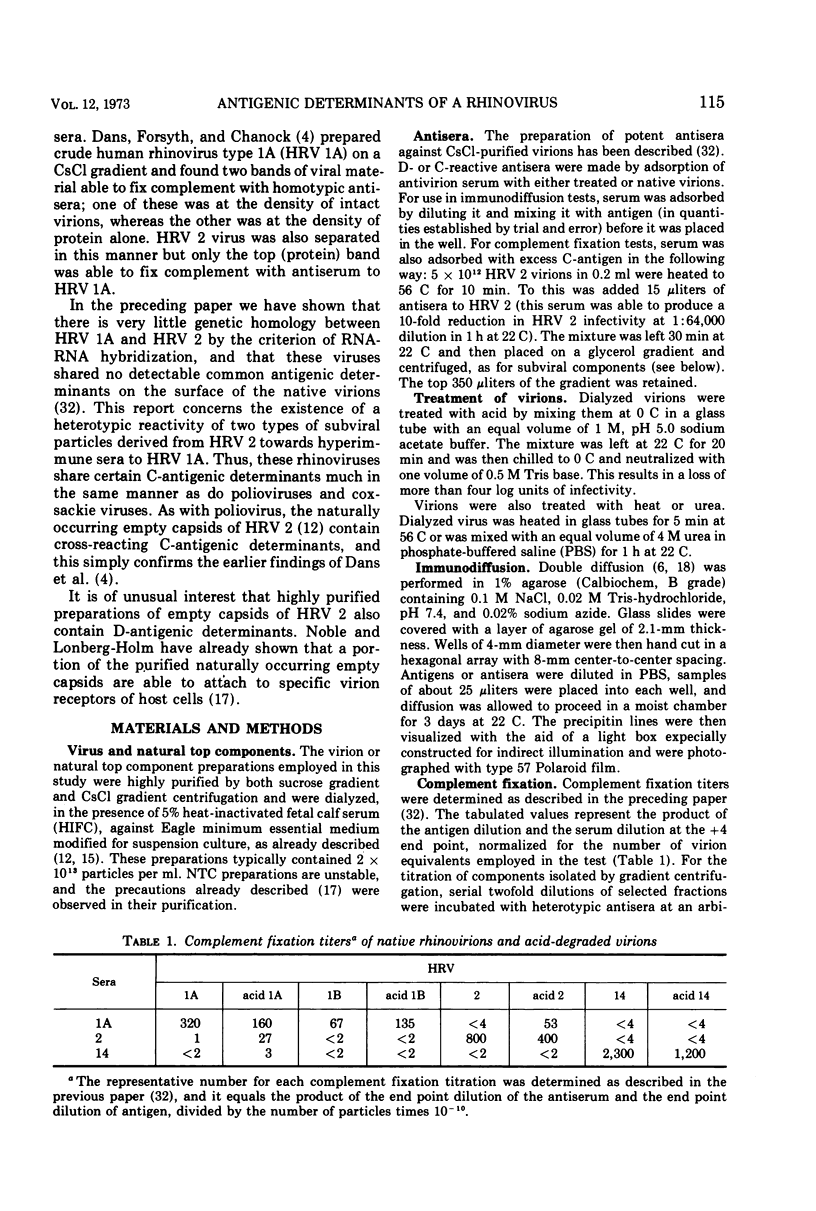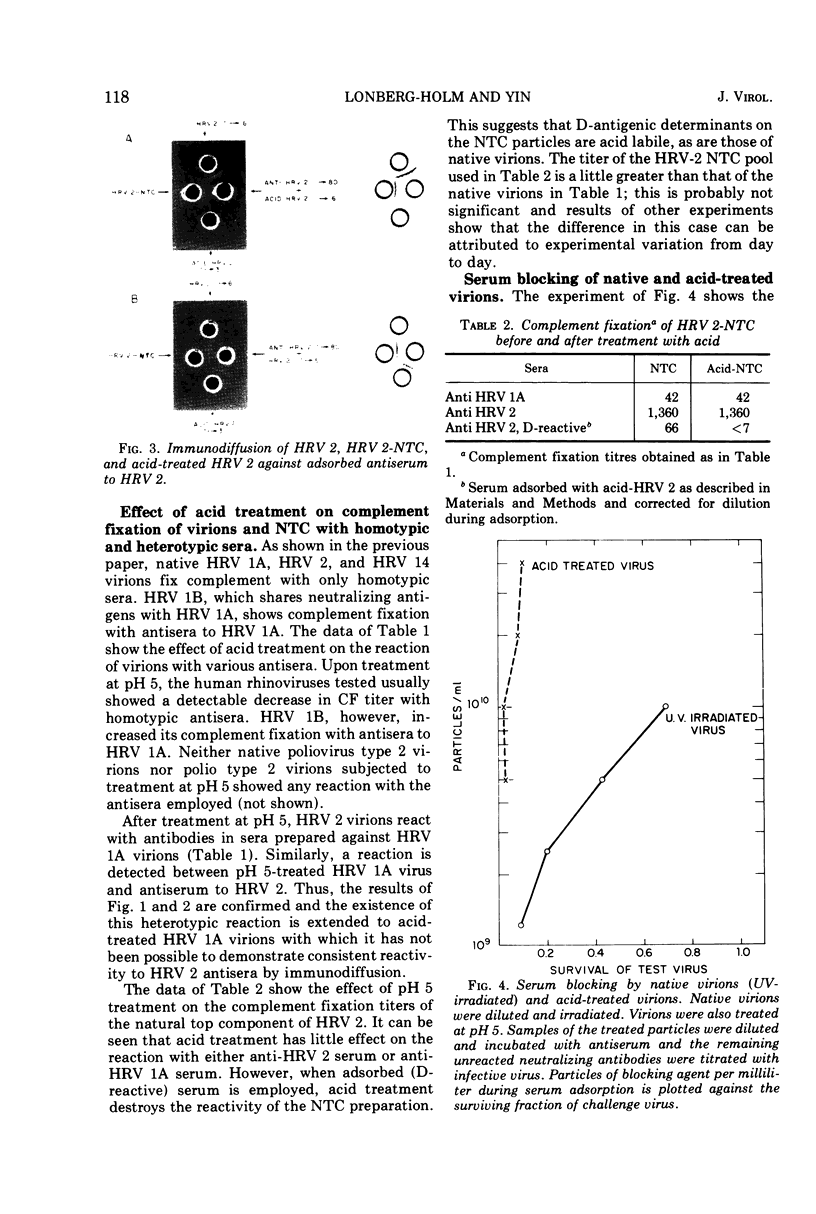Abstract
Treatment of human rhinovirus type 2 (HRV 2) virions at pH 5, at 56 C or in 2 M urea, produces one or both of two types of subviral particles. These subviral particles sediment at 135S or at 80S and both share what have been designated as C-antigenic determinants; the determinants of native virions have been designated D. These sets of determinants have been contrasted by the techniques of immunodiffusion, complement fixation, and serum blocking, and the results indicate that many or most of the D-determinants are lost in the conversion to C antigenicity. Some of the HRV 2 C-determinants also react, in immunodiffusion and in complement fixation tests, with antisera produced against HRV 1A virions. The inverse reaction has also been detected by complement fixation. Purified natural top component (NTC) of HRV 2 contains C- and, to a lesser extent, D-determinants. The D-determinants of NTC are also, like those of virions, lost upon treatment at pH 5. These results are discussed in terms of a conformational model for the D- to C-antigenic conversion.
Full text
PDF









Images in this article
Selected References
These references are in PubMed. This may not be the complete list of references from this article.
- Breindl M. The structure of heated poliovirus particles. J Gen Virol. 1971 Jun;11(3):147–156. doi: 10.1099/0022-1317-11-3-147. [DOI] [PubMed] [Google Scholar]
- Breindl M. VP 4, the D-reactive part of poliovirus. Virology. 1971 Dec;46(3):962–964. doi: 10.1016/0042-6822(71)90097-3. [DOI] [PubMed] [Google Scholar]
- COOPER P. D. Studies on the structure and function of the poliovirion: effect of concentrated urea solutions. Virology. 1962 Apr;16:485–495. doi: 10.1016/0042-6822(62)90230-1. [DOI] [PubMed] [Google Scholar]
- DE MARS R. I. The production of phage-related materials when bacteriophage development in interrupted by proflavine. Virology. 1955 May;1(1):83–99. doi: 10.1016/0042-6822(55)90007-6. [DOI] [PubMed] [Google Scholar]
- Dans P. E., Forsyth B. R., Chanock R. M. Density of infectious virus and complement-fixing antigens of two rhinovirus strains. J Bacteriol. 1966 Apr;91(4):1605–1611. doi: 10.1128/jb.91.4.1605-1611.1966. [DOI] [PMC free article] [PubMed] [Google Scholar]
- ELEK S. D. The recognition of toxicogenic bacterial strains in vitro. Br Med J. 1948 Mar 13;1(4549):493–496. doi: 10.1136/bmj.1.4549.493. [DOI] [PMC free article] [PubMed] [Google Scholar]
- Frommhagen L. H. The separation and physicochemical properties of the C and D antigens of coxsackievirus. J Immunol. 1965 Nov;95(5):818–822. [PubMed] [Google Scholar]
- HUMMELER K., HAMPARIAN V. V. Studies on the complement fixing antigens of poliomyelitis. I. Demonstration of type and group specific antigens in native and heated viral preparations. J Immunol. 1958 Dec;81(6):499–505. [PubMed] [Google Scholar]
- Katagiri S., Aikawa S., Hinuma Y. Stepwise degradation of poliovirus capsid by alkaline treatment. J Gen Virol. 1971 Oct;13(1):101–109. doi: 10.1099/0022-1317-13-1-101. [DOI] [PubMed] [Google Scholar]
- Katagiri S., Hinuma Y., Ishida N. Biophysical properties of poliovirus particles irradiated with ultraviolet light. Virology. 1967 Jun;32(2):337–343. doi: 10.1016/0042-6822(67)90282-6. [DOI] [PubMed] [Google Scholar]
- Katagiri S., Hinuma Y., Ishida N. Relation between the adsorption to cells and antigenic properties in poliovirus particles. Virology. 1968 Apr;34(4):797–799. doi: 10.1016/0042-6822(68)90101-3. [DOI] [PubMed] [Google Scholar]
- Korant B. D., Lonberg-Holm K., Noble J., Stasny J. T. Naturally occurring and artificially produced components of three rhinoviruses. Virology. 1972 Apr;48(1):71–86. doi: 10.1016/0042-6822(72)90115-8. [DOI] [PubMed] [Google Scholar]
- LE BOUVIER G. L., SCHWERDT C. E., SCHAFFER F. L. Specific precipitates in agar with purified poliovirus. Virology. 1957 Dec;4(3):590–593. doi: 10.1016/0042-6822(57)90088-0. [DOI] [PubMed] [Google Scholar]
- LE BOUVIER G. L. The modification of poliovirus antigens by heat and ultraviolet light. Lancet. 1955 Nov 12;269(6898):1013–1016. doi: 10.1016/s0140-6736(55)93435-8. [DOI] [PubMed] [Google Scholar]
- Lonberg-Holm K., Korant B. D. Early interaction of rhinoviruses with host cells. J Virol. 1972 Jan;9(1):29–40. doi: 10.1128/jvi.9.1.29-40.1972. [DOI] [PMC free article] [PubMed] [Google Scholar]
- MAYER M. M., RAPP H. J., ROIZMAN B., KLEIN S. W., COWAN K. M., LUKENS D. The purification of poliomyelitis virus as studied by complement fixation. J Immunol. 1957 Jun;78(6):435–455. [PubMed] [Google Scholar]
- Noble J., Lonberg-Holm K. Interactions of components of human rhinovirus type 2 with Hela cells. Virology. 1973 Feb;51(2):270–278. doi: 10.1016/0042-6822(73)90427-3. [DOI] [PubMed] [Google Scholar]
- ROIZMAN B., MAYER M. M., RAPP H. J. Immunochemical studies of poliovirus. III. Further studies on the immunologic and physical properties of poliovirus particles produced in tissue culture. J Immunol. 1958 Nov;81(5):419–425. [PubMed] [Google Scholar]
- ROIZMAN B., MAYER M. M., ROANE P. R., Jr Immunochemical studies of poliovirus. IV. Alteration of the immunologic specificity of purified poliomyelitis virus by heat and ultraviolet light. J Immunol. 1959 Jan;82(1):19–25. [PubMed] [Google Scholar]
- Rowlands D. J., Cartwright B., Brown F. Evidence for an internal antigen in foot-and-mouth disease virus. J Gen Virol. 1969 Jun;4(4):479–487. doi: 10.1099/0022-1317-4-4-479. [DOI] [PubMed] [Google Scholar]
- SCHAFFER F. L., SCHWERDT C. E. Purification of poliomyelitis viruses propagated in tissue culture. Virology. 1956 Oct;2(5):665–678. doi: 10.1016/0042-6822(56)90046-0. [DOI] [PubMed] [Google Scholar]
- SCHARFF M. D., MAIZEL J. V., Jr, LEVINTOW L. PHYSICAL AND IMMUNOLOGICAL PROPERTIES OF A SOLUBLE PRECURSOR OF THE POLIOVIRUS CAPSID. Proc Natl Acad Sci U S A. 1964 Feb;51:329–337. doi: 10.1073/pnas.51.2.329. [DOI] [PMC free article] [PubMed] [Google Scholar]
- SCHMIDT N. J., DENNIS J., FROMMHAGEN L. H., LENNETTE E. H. SEROLOGIC REACTIVITY OF CERTAIN ANTIGENS OBTAINED BY FRACTIONATION OF COXSACKIE VIRUSES IN CESIUM CHLORIDE DENSITY GRADIENTS. J Immunol. 1963 Apr;90:654–662. [PubMed] [Google Scholar]
- SCHMIDT N. J., DENNIS J., LENNETTE E. H., HO H. H., SHINOMOTO T. T. ANTIBODY RESPONSES OF RHESUS (MACACA MULATTA) MONKEYS EXPERIMENTALLY INFECTED WITH COXSACKIEVIRUSES OF GROUP B AND GROUP A, TYPE 9. I. ANTIBODY RESPONSES WITH THE COXSACKIEVIRUS GROUP. J Immunol. 1965 Jul;95:54–69. [PubMed] [Google Scholar]
- SCHMIDT N. J., LENNETTE E. H., DENNIS J. GEL DOUBLE DIFFUSION STUDIES WITH GROUP B AND GROUP A, TYPE 9, COXSACKIEVIRUSES. 3. ANTIGEN-ANTIBODY ABSORPTION TESTS. J Immunol. 1965 Apr;94:482–491. [PubMed] [Google Scholar]
- SCHMIDT N. J., LENNETTE E. H. Gel double diffusion studies with group B and group A, type 9 Coxsackie viruses. I. The technique and reactions obtained with hyperimmune animal sera and human sera. J Immunol. 1962 Jul;89:85–95. [PubMed] [Google Scholar]
- SCHMIDT N. J., LENNETTE E. H. Modification of the homotypic specificity of poliomyelitis complement-fixing antigens by heat. J Exp Med. 1956 Jul 1;104(1):99–120. doi: 10.1084/jem.104.1.99. [DOI] [PMC free article] [PubMed] [Google Scholar]
- Schmidt N. J., Dennis J., Lennette E. H. Antibody responses of rhesus (Macaca mulatta) monkeys experimentally infected with coxsackieviruses of group B and group A, type 9. II. Heterotypic antibody responses to echoviruses, polioviruses and reovirus type 1. J Immunol. 1967 May;98(5):1060–1066. [PubMed] [Google Scholar]
- Watanabe Y., Watanabe K., Katagiri S., Hinuma Y. Virus-specific proteins produced in HeLa cells infected with poliovirus: characterization of subunit-like protein. J Biochem. 1965 Jun;57(6):733–741. doi: 10.1093/oxfordjournals.jbchem.a128139. [DOI] [PubMed] [Google Scholar]
- Yin F. H., Lonberg-Holm K., Chan S. P. Lack of close relationship between three strains of human rhinoviruses as determined by their RNA sequences. J Virol. 1973 Jul;12(1):108–113. doi: 10.1128/jvi.12.1.108-113.1973. [DOI] [PMC free article] [PubMed] [Google Scholar]





